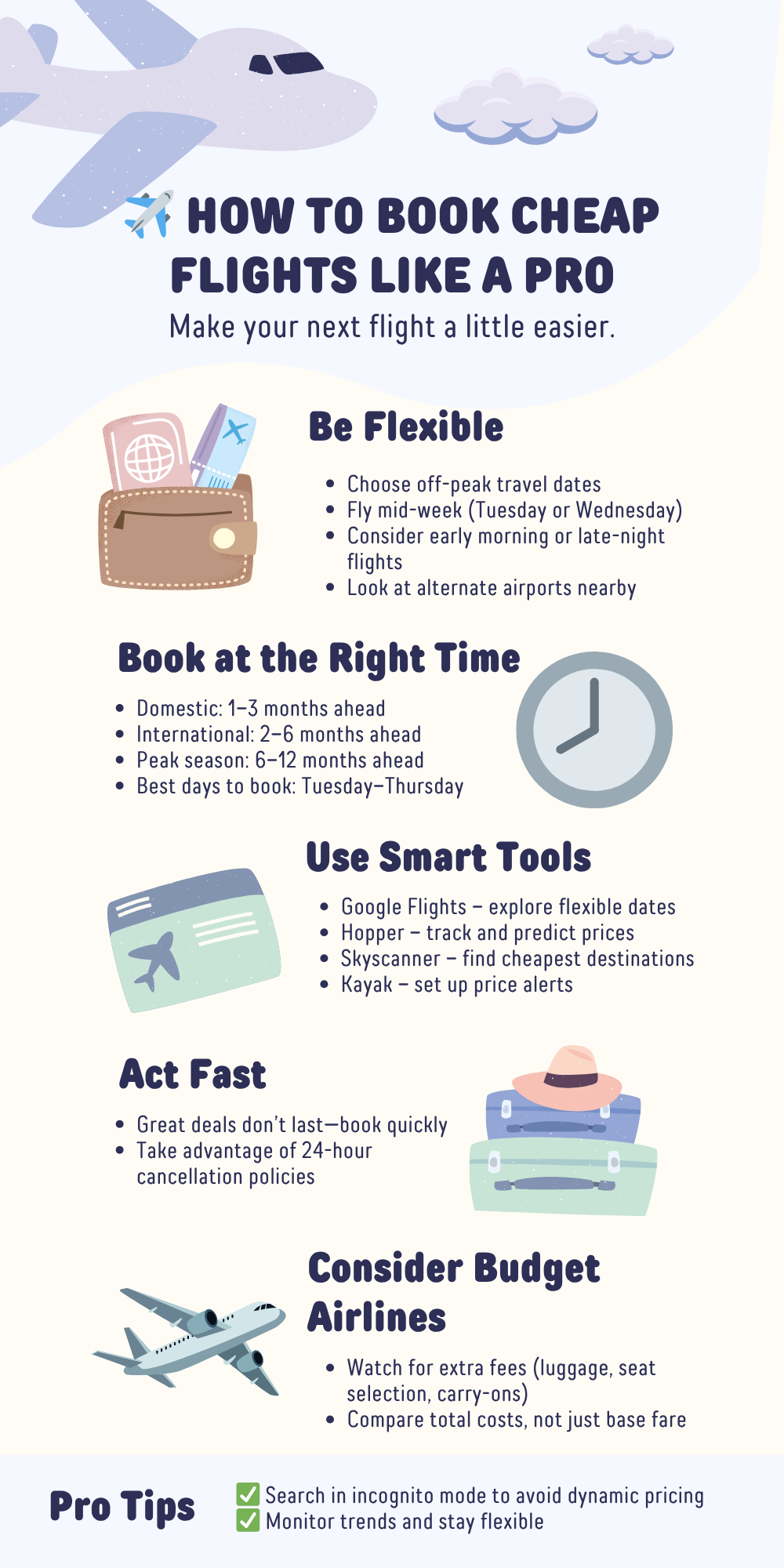How to Book Cheap Flights Like a Pro: Insider Strategies and Timing Tips

Airfare is often one of the largest expenses when planning a trip. Yet savvy travelers know that getting a good deal on flights doesn’t have to be a matter of luck. With the right strategies and timing, you can save hundreds of dollars on your next journey.
This guide explains how to book cheap flights like a pro—whether you’re flying domestically or internationally. It also answers one of the most common questions: when is the best time to book flights?
Why Cheap Flights Are Not Always Obvious
Airline pricing is a complex algorithm that responds to demand, route popularity, seasonality, fuel costs, competition, and even day-of-week booking trends. That’s why two passengers on the same plane may pay drastically different fares.
Fortunately, there are patterns and tools you can use to find the lowest possible price. Below are professional-level strategies that travel experts use to book smart and save.
1. Start With Flexibility
The more flexible you can be with your dates, destination, and even departure airport, the more options you’ll have to find a cheap flight.
-
Dates: Flying mid-week (Tuesday or Wednesday) is usually cheaper than weekends. Avoid peak holidays or school vacation periods if possible.
-
Time of day: Early-morning or late-night flights tend to be less expensive and less crowded.
-
Alternate airports: Search for flights from nearby airports—sometimes a short drive can save you significant money.
Pro Tip: Use flexible-date search tools such as Google Flights or Skyscanner to see a calendar view of prices and pick the cheapest days.
2. Know the Best Time to Book
When you book your ticket can be just as important as where and when you fly.
Domestic Flights (Within the Same Country)
-
The sweet spot is typically 1–3 months before departure for domestic flights.
-
Booking too far in advance or too late can lead to higher fares.
International Flights
-
Aim to book 2–6 months in advance for international flights.
-
For very popular seasons (like summer in Europe), it’s wise to book closer to the 6-month mark.
Specific Day of the Week
Contrary to popular myth, there isn’t a magical day to book—but data suggests mid-week (Tuesday–Thursday) bookings tend to offer more competitive fares, likely because airlines release sales on Mondays and adjust prices by Tuesday.
Best Time of Year to Buy
-
January and February are good months to book flights for the coming year, especially for spring and fall travel.
-
End-of-summer (late August and September) often brings discounts on flights to Europe and Asia.
3. Use the Right Tools
These platforms and tools can help you track fares and uncover deals:
✅ Google Flights: Excellent for flexible-date searches and spotting price trends.
✅ Hopper: Predicts price trends and sends alerts when it’s the right time to book.
✅ Skyscanner: A great tool for exploring the cheapest destinations from your departure city.
✅ Kayak Price Alerts: Allows you to set alerts and monitor fares over time.
Pro Tip: Always compare prices directly on the airline’s website before booking—sometimes they offer exclusive deals or waived fees.
4. Be Ready to Act Fast
Great deals don’t last long. If you see a price that’s much lower than usual for your route and dates, book it. Many airlines offer a 24-hour free cancellation window, so you can lock in the fare and adjust plans if necessary.
5. Consider Budget Airlines—With Caution
Low-cost carriers can save you money, but make sure to factor in all fees. Budget airlines often charge extra for luggage, seat selection, and even carry-ons. Compare the total cost—not just the base fare—before deciding.
6. Use Points and Miles Strategically
Frequent flyer miles, credit card points, and airline rewards programs can be incredibly valuable. Even if you don’t travel often, using a travel rewards credit card can help you earn points for flights over time.
7. Watch Out for Dynamic Pricing
Some believe that searching for the same flight repeatedly causes prices to rise due to cookies in your browser. While the evidence is mixed, it doesn’t hurt to search in incognito mode or on different devices to compare.

Summary: Timing Is Everything
Here’s a quick recap of the timing rules for cheap flights:
| Type of Flight | When to Book |
|---|---|
| Domestic | 1–3 months before departure |
| International | 2–6 months before departure |
| Peak Season | As early as possible (up to 6–12 months) |
| Mid-week Departure | Usually cheaper (Tuesday or Wednesday) |
Booking cheap flights like a pro requires a mix of flexibility, timing, and the right tools. While you can’t control airline pricing, you can make informed decisions that put you ahead of the average traveler.
By planning strategically and staying alert to deals, you can save money and travel more often—without sacrificing quality or convenience.
So next time you’re planning a trip, remember: be flexible, start early, and monitor fares like a pro.
Happy travels!


